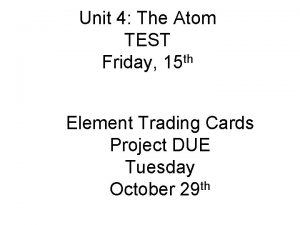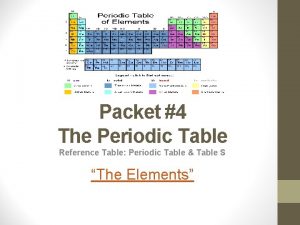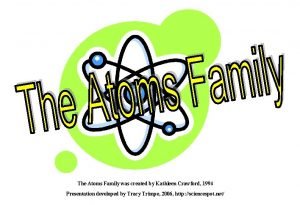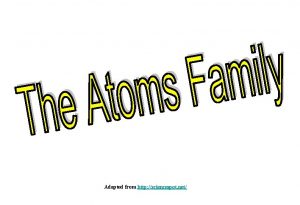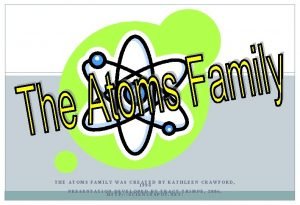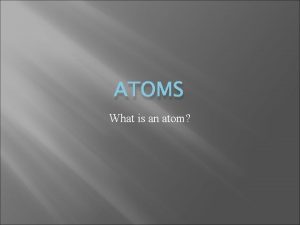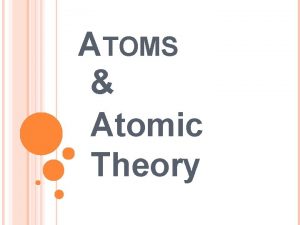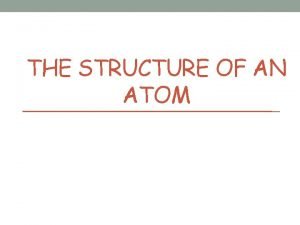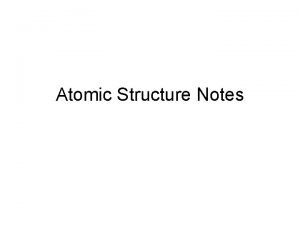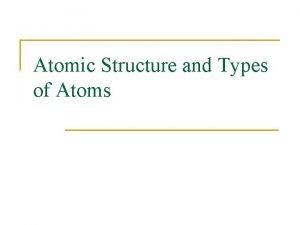THE STRUCTURE OF AN ATOM Atomic Structure Atoms













- Slides: 13

THE STRUCTURE OF AN ATOM

Atomic Structure • Atoms are composed of 2 regions: • Nucleus: center of atom that contains mass of atom • Electron cloud: region that surrounds nucleus that contains most of space in atom Electron Cloud Nucleus

What’s in the Nucleus? • Nucleus contains 2 of 3 subatomic particles: • Protons: subatomic particle w/ 1+ charge (p +) • Rutherford - 1911 • Neutrons: subatomic particle w/ no charge (no)

What’s in the Electron Cloud? • The 3 rd subatomic particle resides outside nucleus in electron cloud • Electron: subatomic particle w/ 1 - charge (e - ) and virtually no mass

How do these particles interact? • Protons and neutrons live compacted in tiny nucleus • most atom’s mass • electrons small and reside outside nucleus • small mass (2000 e- = 1 p+ or no) • occupy large volume of space outside nucleus

How do we know the number of subatomic particles in an atom? • Atomic #: indicates # of protons in atom • Ex: Hydrogen’s atomic # is 1 • hydrogen has 1 proton • Ex: Carbon’s atomic # is 6 • carbon has 6 protons **Number of protons identifies element similar to how your fingerprint ID’s you. Ex. 2 protons = He, 29 protons = Cu ALWAYS!!

How do we know the number of subatomic particles in an atom? • Mass number: number of protons and neutrons in nucleus (p+ + no) • Ex: hydrogen can have a mass # of 3. Since it has 1 proton it must have 2 neutrons • # of neutrons = mass # - atomic #

What are Isotopes? • Atoms of same element with different # of neutrons • Same atomic # • Different mass # (b/c neutrons are different) • Ex. Carbon 12, Carbon 13, and Carbon 14 all naturally occurring isotopes of Carbon. • Each has 6 p+ and 6 e-, but each has different # of neutrons (therefore, different mass#)

Determining the number of protons and neutrons • Li has mass # of 7 and atomic # of 3 • Protons = 3 (same as atomic #) • Neutrons= 7 -3 = 4 (mass # - atomic #) • Ne has a mass # of 20 and an atomic # of 10 • Protons = 10 • Neutrons = 20 - 10= 10

What about the electrons? • electrons are equal to protons • So e- = p+ = atomic # • Ex: He has mass # of 4 and atomic # of 2 • p+ = 2 • no = 2 • e- = 2 Basic Atomic Structure 1: 57

Determine the number of subatomic particles in the following: • Chlorine has a mass # of 35 and an atomic # of 17 • p+ = 17, no = 18, e- = 17 • Potassium has a mass # of 39 and an atomic # of 19 • P+ = 19, no = 20 e- = 19

Candy Atoms • Atom #1 - mass # of 5 and an atomic # of 3. • Atom #2 – 5 protons and 7 neutrons. • Atom #3 – Atomic # of 7 and 8 neutrons.

Candy Atoms • Atom #4 – mass # 18 and 9 electrons • Atom #5 – build your own candy atom using the candies that you have. You should be able to accurately determine: • Atomic # • Mass # • # of protons, neutrons, and electrons
 At stp which substance is the best conductor of electricity
At stp which substance is the best conductor of electricity The structure of the atom section 2 defining the atom
The structure of the atom section 2 defining the atom Matterville answer key
Matterville answer key Periodic table reference table
Periodic table reference table Matterville worksheet
Matterville worksheet Matterville
Matterville Matterville worksheet
Matterville worksheet The atoms family atomic math challenge
The atoms family atomic math challenge What is the lowest allowable energy state of an atom
What is the lowest allowable energy state of an atom Electrons in atoms section 2 quantum theory and the atom
Electrons in atoms section 2 quantum theory and the atom Relative formula mass of hcl
Relative formula mass of hcl What are the trends in the periodic table
What are the trends in the periodic table Trend of atomic radius
Trend of atomic radius Atomic weight of oxygen
Atomic weight of oxygen


